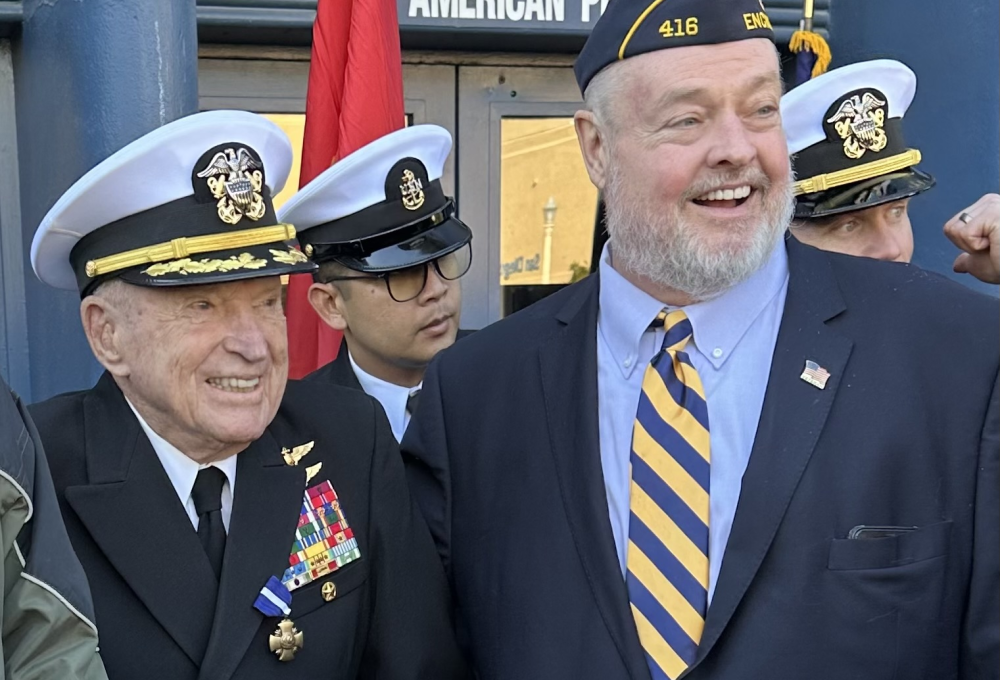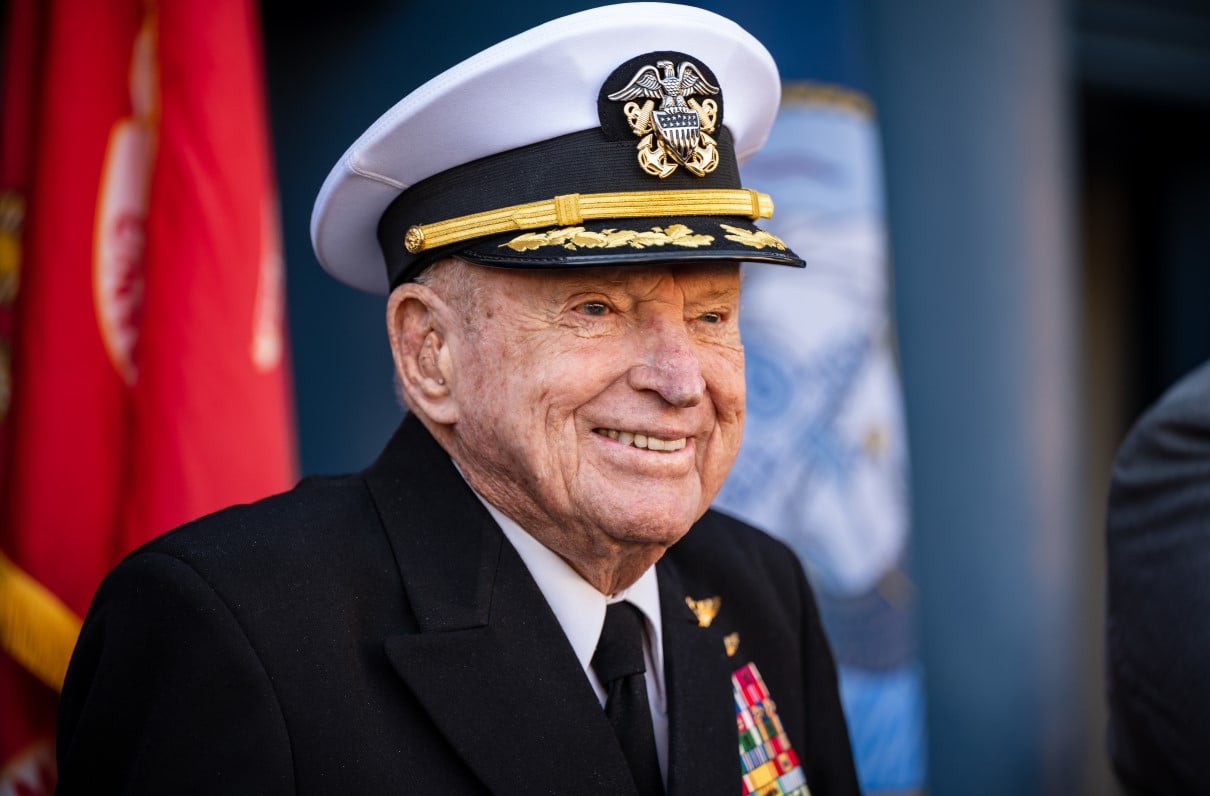By Charlsy Panzino
A 98-year-old retired Navy pilot kept a classified Navy mission and his heroism in the Korean War to himself for more than half a century. Now, other veterans and members of Congress are continuing their advocacy on his behalf to secure the highest military award for his actions.
On Nov. 18, 1952, Capt. Royce Williams, USN (Ret), was in a 35-minute dogfight against seven Soviet MiG-15s — the longest dogfight in U.S. military history, according to the U.S. Naval Institute —at a point when the Soviet Union was not publicly known to be involved in the Korean War. The mission was classified, and Williams, a MOAA member, kept the details a secret, including from his wife and brother.
Then-Lt. Williams received the Silver Star in 1953 for his actions, but the citation didn’t specify that the enemy aircraft were from the Soviet Union, and it said Williams shot down at least one of the planes and probably a second.
After the Soviet Union collapsed in the early 1990s, however, information from Russia came out showing that Williams shot down four of the MiGs, and that only one of the seven returned.
Upon learning this, Navy veterans and members of Congress started working toward getting Williams recognized for what really happened that November day. Efforts to award Williams the Medal of Honor through the FY 2023 National Defense Authorization Act (NDAA) faltered in 2022 since the complete details of his mission weren’t recorded, but the push from veterans — including Rear Adm. Don Shelton, USN (Ret) — and Rep. Darrell Issa (R-Calif.) led to Navy Secretary Carlos Del Toro awarding Williams the Navy Cross, an upgrade to his Silver Star, in January. Then in April, the 98-year-old veteran received the Taegeuk Order of Military Merit from South Korea President Yoon Suk Yeol.
[RELATED: 70 Years After Dogfight Over Korea, MOAA Member Honored With Navy Cross]
The House version of the FY 2024 NDAA contains an amendment from Issa upgrading Williams’ Navy Cross to the Medal of Honor.
“The heroism of Royce Williams is to this day the most unique U.S.-Soviet aerial combat dogfight in the history of the Cold War, and one in which Royce Williams performed an act of indomitable courage of the highest skill under incalculable duress,” Issa said in a statement to MOAA. “It is my honor to fight for Royce to gain a recognition that he has not sought, but so richly deserves.”
Navy veteran Lt. Steve Lewandowski is also spearheading the effort after learning about Williams’ story through Shelton, who died in 2021. The Medal of Honor effort — known as Operation Just Reward — has the endorsement of about 120 admirals and generals.
“Now because of the Navy Cross and the South Korea medal, we’re hoping there’s just more awareness,” Lewandowski said, adding that Williams went above and beyond the call of duty and deserves the Medal of Honor. “Wouldn’t it be great if we could do that when this great man is still with us?”

Navy veteran Lt. Steve Lewandowski, right, smiles alongside Capt. Royce Williams, USN (Ret), during Williams’ Navy Cross ceremony in San Diego. (Courtesy Photo)
35 Minutes
In November 1952, Williams was part of a task force sent from its normal operating area along the 38th parallel to the northern border of North Korea to investigate several important targets, said Williams, who was piloting an F9F-5 Panther assigned to the carrier USS Oriskany.
Williams was on the first flight of the day when they started pounding manufacturing and warehousing targets. On his next flight, they went up as a team of four under heavy clouds.
“We were in a blizzard — really bad weather,” he said, adding that they were climbing in the clouds when their combat information center said there were unknown aircraft coming in from the north.
“Where we were, that pretty much pointed toward Russia,” Williams said.
When he and his team climbed out of the clouds, they saw seven contrails overhead. The flight leader’s plane was losing engine oil and he was directed to turn back with his wingman, so Williams and his wingman flew on. Williams was told to intercept the unknown aircraft, so he flew at the contrails but couldn’t see the planes yet. The carrier also lost contact with the unknown aircraft and directed Williams to return and provide a barricade between the potential enemy aircraft and the Navy ships.
[RELATED: MOAA Member Larry Taylor Receives Medal of Honor]
“While I was doing that, I was attacked by four, and they were all shooting,” Williams said. “And so the game was on.”
He was told not to engage, but he said there was no point because if he had disengaged, he would have been shot down. Williams’ wingman followed one of the planes down, so he was left to fight against six of the seven MiGs.
“From that point on, they made their attacks one at a time,” he said. “My efforts and attention were to the one in a position to shoot me. My maneuvers were to prevent that.”
In any other scenario, Williams said he would have lost the fight.
“They would occasionally make a mistake, and I’d capitalize on it,” he said. “I kept hitting them with these opportunities.”
He could see the damage to the enemy aircraft and had to avoid debris coming off their planes and avoid running into them.
Williams’ plane didn’t make it out unscathed, and he eventually ran out of ammunition and lost control of the rudder, which meant he was piloting an elevator – going up and down, but not turning. After getting back into the clouds and losing the enemy aircraft, Williams had to navigate down to the carrier with his bullet-ridden plane.
“It was difficult and probably almost unimaginable, but I did it,” he said.
Modern Obstacles
Lewandowski said he was told that the NDAA amendment was difficult to pass in 2022 because Williams’ true mission wasn’t on the books anymore. Williams’ supporters tried to obtain that information through the Freedom of Information Act and through the National Security Agency, but it proved difficult.
“Depending on who you talked to, either that information was destroyed or misplaced,” Lewandowski said, adding that it probably wasn’t as glamorous as being destroyed and was most likely lost over the 70 years of different administrations and filing systems.
Williams was more or less told that “this did not happen” after his mission since releasing information that the Soviet Union was involved in the Korean War could have catastrophic implications, Lewandowski said.
“I just handled it as obeying an order, and it became easier in time,” Williams said.
The veteran is amazed by all of the people supporting the effort to receive the Medal of Honor, and he’s also grateful that he could finally speak publicly about his mission that day.
“Nobody knowing the truth about it was kind of a big disappointment, so I just bit my tongue and stayed quiet,” he said, adding that receiving the Medal of Honor would be a culmination of everything he’s been through.
“I know that there’s a lot of interest and so forth [in that mission], but it’s only an hour and a half out of a 37-year career,” Williams said. “I had a lot of thrilling events that happened over all those years, and I was doing what I wanted to do — my childhood dream, and I got to do it.”
Charlsy Panzino is a writer based in Idaho.
Want to Help Servicemembers in Your Community?
Learn how you can make a difference with your local chapter.
